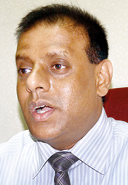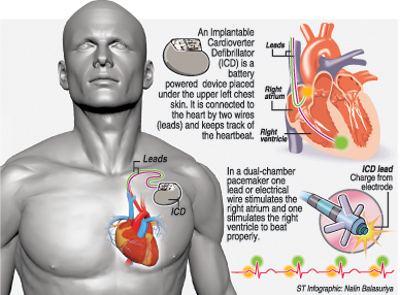Latest device to keep heart in check
It is a Sri Lankan patient in her mid-70s who holds the record not only for being the first in this country but in the whole of South Asia to be fitted with a dual-chamber implantable cardioverter defibrillator (ICD) that is compatible with magnetic resonance imaging (MRI).

Dr. Asunga Dunuwille
The patient was in double jeopardy, MediScene understands, before the MRI-compatible dual-chamber ICD was fitted in this latest technology to be introduced in the field of cardiac-electrophysiology or in plain terms the heart’s electrical impulses.
A heart attack she had suffered some time ago had lessened the heart functions. She was a victim of arrhythmias (see box) while on and off she was also prone to heart blocks which made her faint, said Consultant Cardiac Electrophysiologist, Dr. Asunga Dunuwille, who inserted this device in an operation lasting less than two hours on December 3 at the Durdans Hospital in Colombo 3.
The ICD is a good device for those whose hearts become dangerously fast, says Dr. Dunuwille who is attached to the National Hospital’s Cardiology Institute, adding that the specialised field of Cardiac Electrophysiology in Sri Lanka is on par with any developed country including America.
The importance of this latest device lies in the fact that for this patient, like many others in the country who also needs a series of MRI scans for other illnesses the normal ICD, would just not do, it is understood.
Pacemakers and normal ICDs which are battery-operated shut down when there is another magnetic field. This is a major disadvantage for those needing essential MRIs.This problem has been overcome by the world’s first MRI-compatible ICD, which like the normal ICD can be implanted in the upper left chest muscle about an inch under the skin.
During surgery to insert this MRI-compatible dual-chamber ICD, a faster heart rate is induced to check the “shocking function” of the “shocking coil” of the device, says Dr. Dunuwille, explaining that the device is then programmed to go into action when the patient suffers an arrhythmia.
This dual-chamber device has a double benefit as it comes in handy either when the heart rate goes faster or slower, when an arrhythmia occurs, MediScene understands. The device will shock the heart for the heartbeat that is fast to return to normal, while taking on the role of a pacemaker when the heartbeat is slow.

Tracing the history of heart device-implantation, Dr. Dunuwille is quick to point out that while in developed countries pacemakers have been used for over 50 years, in Sri Lanka they have been around since the 1980s. ICDs have been used for about 25 years the world over and in Sri Lanka these specialized arrhythmia services have been in existence since 2003.
MRI-compatible devices have been in the world market only for about two years and now we have them in Sri Lanka, says Dr. Dunuwille. Therefore, patients do not need to seek treatment abroad not only facing a far greater cost but also undergoing the inconvenience of travelling out of the country, he adds.
Specialised cardiac electrophysiological support is available at the NHSL in Colombo, the Kandy Teaching Hospital and selected private hospitals in Colombo.
Role of pacemakers and ICDs
There is a “natural pacemaker” located in the upper-right area of every heart which sends out an electrical current to keep the heart rhythm as it should be, MediScene understands.
When this pacemaker gets diseased, the rhythm gets disrupted and the heart beats slower or irregularly. It is to correct this that a pacemaker, a small device, is implanted. An ICD which is a more complex pacemaker, is implanted in those with dangerously fast heart rates, says Dr. Asunga Dunuwille.
Explaining the difference, he says that while a basic pacemaker sends electrical pulses throughout to coax the heart to beat normally, an ICD will send a ‘shock’ only when there is a necessity in certain conditions.
Arrhythmia problem
A lesson on the heart follows from Dr. Asunga Dunuwille. When asked about prevalence, he says that 1 of 10 cardiac patients would have an arrhythmia problem. Arrhythmias are due to heart-rhythm problems, when the electrical impulses that coordinate the heartbeats go awry, making the heart to beat too fast, too slow or irregularly, MediScene learns. A “fluttering” or “racing” heart may indicate an arrhythmia. Often harmless, sometimes though they may be bothersome or even life-threatening.
Faster heart rates may occur due to various reasons and in most instances there is no danger of sudden cardiac death, says Dr. Dunuwille, citing supra ventricular tachycardia (SVT) as an example. This condition which presents as a fast heartbeat, where the heart races and then slows or stops abruptly, does not require device-implantation, but can be cured by radiofrequency ablation.
However, in certain ventricular tachycardia conditions (a rapid heartbeat that starts in the ventricles) there is the danger of sudden cardiac death, according to Dr. Dunuwille and as such need device implantation.
Ventricular tachycardia could be caused by:
Structural heart disease either due to changes in the heart following a heart attack or some other cardiomyopathy (a weakening of the heart muscle hindering the pumping action). This includes hypertrophic cardiomyopathy where the heart muscle becomes thick which affects the compliance of the heart-wall, reducing its stretchability and contractability. This condition which could exist in apparently healthy sportspersons can lead to sudden cardiac death and needs a device implantation.
Electrical-cardiomyopathy which causes Long QT Syndrome (disorder of the heart’s electrical activity) and Brugada Syndrome also need devices.
Pacemakers are also required for patients with symptomatic Bradycardia — a condition where the heartbeat slows so that the pulse rate is less than 60 or lower per minute – including Sick Sinus Syndrome and heart blocks, it is learnt.



